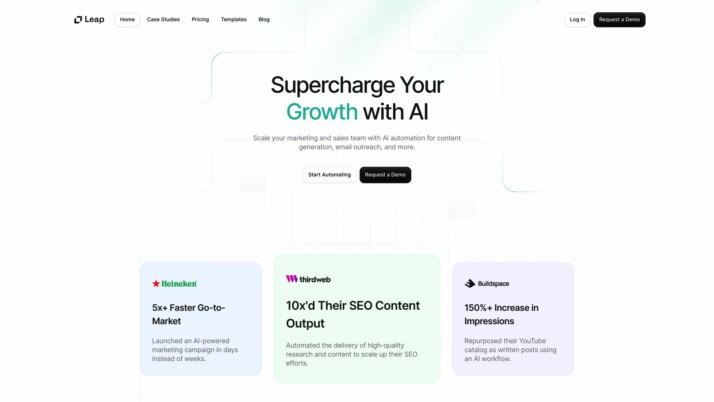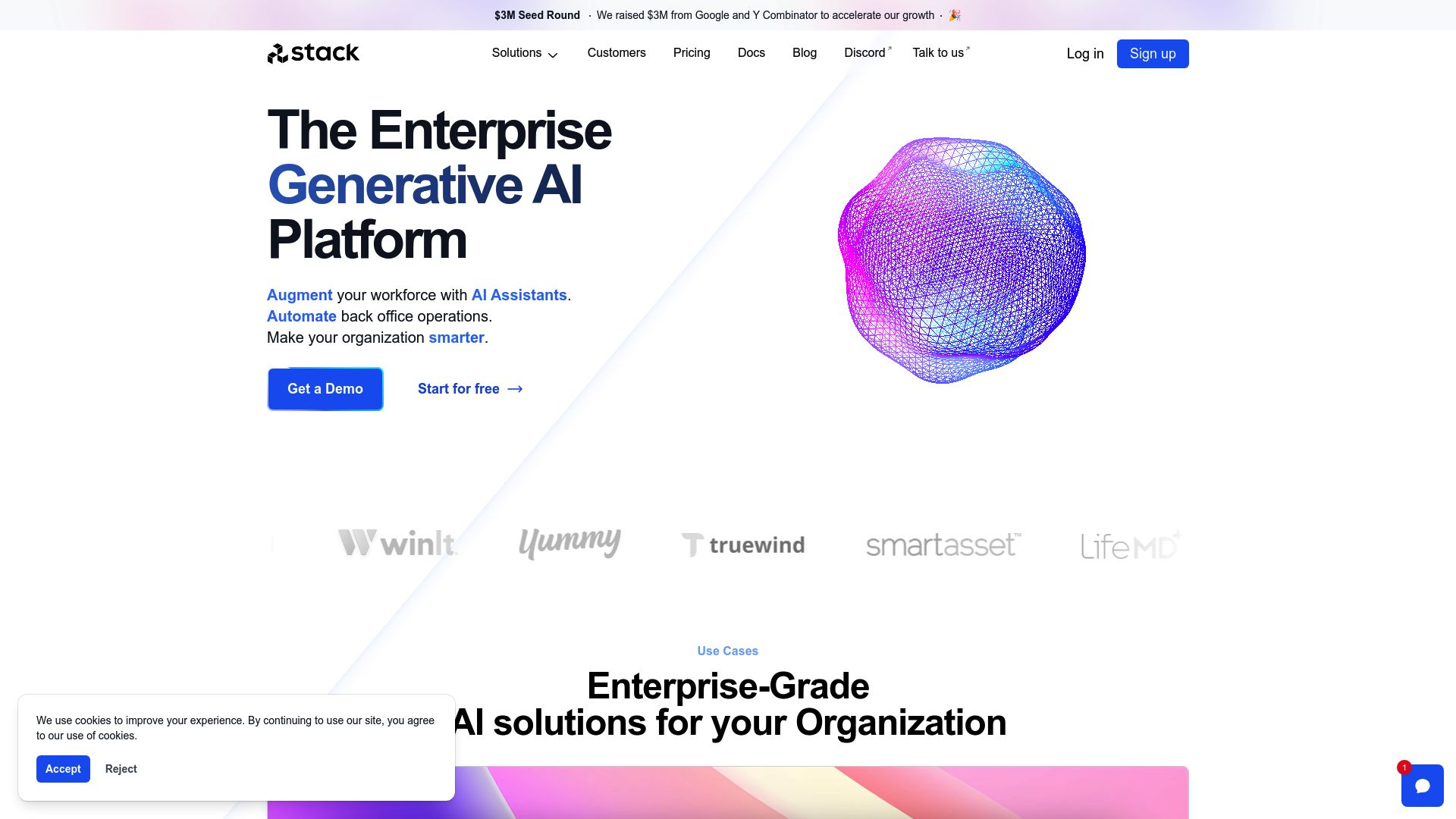Leap AI vs. Stack AI: Comparing No-Code AI Platforms
AI platforms are revolutionizing software development, empowering users to create sophisticated applications without extensive coding knowledge. This comparison of Leap AI vs. Stack AI, and SmythOS explores how each platform addresses the growing demand for accessible yet powerful AI tools. We’ll examine their key features, strengths, and limitations to help you determine which solution best fits your AI development needs. Whether you’re a developer seeking advanced integrations, a business leader focused on scalability and compliance, or a non-technical professional looking for user-friendly tools, this review provides insights to guide your decision-making process in harnessing AI’s transformative potential.
Leap AI Overview
Leap AI empowers users to create sophisticated AI workflows without coding expertise. The platform’s drag-and-drop interface and extensive template library enable rapid development of AI-powered applications for tasks ranging from content generation to data analysis.
Leap AI’s core strength lies in its versatility and accessibility. The platform supports integration with popular AI models like OpenAI GPT and Stable Diffusion XL, allowing users to leverage cutting-edge AI capabilities for diverse use cases. Leap AI’s no-code approach democratizes AI development, making it accessible to both technical and non-technical users alike.


Screenshot of Leap AI Website
Leap AI’s no-code approach democratizes AI development, making it accessible to both technical and non-technical users alike.
Leap AI offers comprehensive SDK support, including RESTful API, TypeScript, and Python, facilitating seamless integration into existing applications. The platform’s ability to connect with widely-used tools such as Slack, Hubspot, and Zapier further enhances its utility across various business processes. Leap AI also provides features for training and fine-tuning custom AI models, enabling users to create highly specialized solutions tailored to their unique needs.
While Leap AI excels in many areas, it lacks some advanced features found in other platforms. The absence of hosted agents, autonomous agents, and multi-agent collaboration capabilities may limit its suitability for complex, enterprise-level AI deployments. Additionally, the platform does not offer a hosted vector database or specific tools for explainability and transparency, which could be crucial for certain applications or industries with strict regulatory requirements.
Despite these limitations, Leap AI’s focus on user-friendly AI development and integration makes it a compelling choice for businesses and individuals looking to harness AI power without extensive technical resources. The platform’s vision of democratizing AI aligns well with the growing demand for accessible yet powerful AI tools in today’s rapidly evolving technological landscape.
Stack AI Overview
Stack AI empowers users to create AI-powered workflows and custom AI assistants without extensive coding expertise. The platform’s no-code interface democratizes access to advanced AI capabilities, enabling rapid development of intelligent applications across various industries.


Stack AI’s drag-and-drop interface simplifies the creation of AI-driven solutions, making it accessible to both technical and non-technical users. The platform offers a library of pre-built templates for common use cases, which users can customize to fit specific needs. This approach accelerates development and deployment of AI applications, reducing time-to-market for businesses seeking to leverage AI technology.
Stack AI’s drag-and-drop interface simplifies the creation of AI-driven solutions, making it accessible to both technical and non-technical users.
The platform prioritizes enterprise-grade security, complying with SOC 2, HIPAA, and GDPR standards to ensure data protection and privacy. Stack AI supports integration with various data sources and services, including Google Drive, Salesforce, Airtable, and Slack, enabling seamless incorporation of AI capabilities into existing workflows. Users can deploy their AI applications through customizable user interfaces or API endpoints, providing flexibility in implementation.
While Stack AI offers significant advantages in terms of ease of use and rapid deployment, it may have limitations in highly specialized or complex AI scenarios that require deep customization. The platform’s focus on accessibility could potentially restrict advanced users who need granular control over AI models. Additionally, as with many no-code platforms, there may be trade-offs between simplicity and the depth of AI capabilities compared to more traditional development approaches.
Feature Comparison
Leap AI and Stack AI both offer no-code AI development platforms, but differ in their core capabilities and target audiences. Leap AI focuses on rapid AI workflow creation with extensive SDK support and integration options. Its strengths lie in its user-friendly interface, diverse AI model support, and custom model training capabilities. However, Leap AI lacks some advanced features that could limit its use in complex enterprise scenarios.
Stack AI, on the other hand, positions itself as an enterprise-grade solution with a strong emphasis on security and compliance. It offers customizable deployments and supports integration with various data sources and services. Stack AI’s pre-built use cases and dedicated customer support make it attractive for businesses seeking to implement AI solutions quickly. However, it may not provide the same level of flexibility in AI model selection and customization as Leap AI.
Both platforms have gaps in core components like hosted agents, autonomous agents, and multi-agent collaboration. Neither offers a hosted vector database or robust tools for explainability and transparency, which could be crucial for certain applications or industries with strict regulatory requirements. These limitations highlight areas where SmythOS excels, offering a more comprehensive suite of advanced AI capabilities and enterprise-ready features.
Feature Comparison Table
| Leap AI | Stack AI | SmythOS | |
|---|---|---|---|
| CORE FEATURES | |||
| Hosted Agents (Dev, Production) | ❌ | ✅ | ✅ |
| Autonomous Agents | ❌ | ✅ | ✅ |
| Explainability & Transparency | ❌ | ✅ | ✅ |
| Debug Tools | ❌ | ✅ | ✅ |
| Multi-Agent Collaboration | ❌ | ✅ | ✅ |
| SECURITY | |||
| Constrained Alignment | ❌ | ❌ | ✅ |
| IP Control | ✅ | ❌ | ✅ |
| COMPONENTS | |||
| Huggingface AIs | ✅ | ❌ | ✅ |
| Data Lakes | ❌ | ✅ | ✅ |
| DEPLOYMENT OPTIONS (EMBODIMENTS) | |||
| Deploy as Scheduled Agent | ✅ | ❌ | ✅ |
| DATA LAKE SUPPORT | |||
| Hosted Vector Database | ❌ | ✅ | ✅ |
| Sitemap Crawler | ✅ | ❌ | ✅ |
| YouTube Transcript Crawler | ✅ | ❌ | ✅ |
Best Alternative to Leap AI and Stack AI
SmythOS stands out as the superior alternative to Leap AI and Stack AI, offering a comprehensive platform for AI agent development and deployment. We provide a powerful, user-friendly solution that addresses the limitations of our competitors while delivering unparalleled flexibility and functionality.
Our visual builder and no-code options make AI development accessible to users of all skill levels, from beginners to seasoned professionals. Unlike Leap AI and Stack AI, SmythOS offers true autonomous agents capable of complex problem-solving and multi-agent collaboration. This enables the creation of sophisticated AI systems that can tackle a wide range of tasks across industries.
SmythOS offers true autonomous agents capable of complex problem-solving and multi-agent collaboration. This enables the creation of sophisticated AI systems that can tackle a wide range of tasks across industries.
SmythOS excels in providing robust debugging tools, explainability features, and comprehensive logs and monitoring capabilities. These features ensure transparency and allow for fine-tuning of AI agents, addressing a critical gap in both Leap AI and Stack AI’s offerings. Our platform also prioritizes security with advanced features like constrained alignment and IP control, surpassing the security measures of our competitors.
Unlike Leap AI and Stack AI, SmythOS offers a hosted vector database and supports a wide array of data sources, including sitemaps, YouTube transcripts, and various file formats. This versatility allows for the creation of AI agents that can work with diverse data types and sources, significantly expanding the potential use cases for our platform.
By choosing SmythOS, users gain access to a cutting-edge AI development platform that combines ease of use with advanced capabilities. Our solution empowers businesses and developers to create AI agents that can handle virtually any task, from simple automation to complex decision-making processes, all while maintaining scalability and security. With SmythOS, the possibilities for AI innovation are truly unlimited.
Conclusion
Leap AI and Stack AI offer powerful no-code AI development platforms, each with unique strengths. Leap AI excels in rapid workflow creation and diverse AI model support, while Stack AI emphasizes enterprise-grade security and pre-built use cases. Both platforms democratize AI development, making it accessible to technical and non-technical users alike.
However, SmythOS emerges as the superior choice, offering a comprehensive suite of advanced AI capabilities that address the limitations of both Leap AI and Stack AI. Our platform provides hosted agents, multi-agent collaboration, and a hosted vector database—features absent in the competing solutions. SmythOS also delivers robust tools for explainability and transparency, crucial for industries with strict regulatory requirements.
SmythOS stands out with its “Create Once, Deploy Anywhere” approach, allowing users to build AI agents that seamlessly integrate across multiple environments. Our drag-and-drop interface, extensive integration ecosystem, and support for various AI models from providers like OpenAI, Anthropic, and Hugging Face make advanced AI functionalities both accessible and powerful.
For businesses and developers seeking to harness the full potential of AI, SmythOS offers unparalleled versatility and scalability. We invite you to explore our diverse range of AI-powered agent templates and experience unlimited AI automation risk-free. Unlock limitless AI integrations with SmythOS and deploy AI agents anywhere to transform your workflow and drive innovation across your organization.
Last updated:
Disclaimer: The information presented in this article is for general informational purposes only and is provided as is. While we strive to keep the content up-to-date and accurate, we make no representations or warranties of any kind, express or implied, about the completeness, accuracy, reliability, suitability, or availability of the information contained in this article.
Any reliance you place on such information is strictly at your own risk. We reserve the right to make additions, deletions, or modifications to the contents of this article at any time without prior notice.
In no event will we be liable for any loss or damage including without limitation, indirect or consequential loss or damage, or any loss or damage whatsoever arising from loss of data, profits, or any other loss not specified herein arising out of, or in connection with, the use of this article.
Despite our best efforts, this article may contain oversights, errors, or omissions. If you notice any inaccuracies or have concerns about the content, please report them through our content feedback form. Your input helps us maintain the quality and reliability of our information.
